#elamite language
Text
youtube
The oldest wedding ring in the world
The king's power ring in the king's coffin
💍👰 + 🏺🔍
One of the oldest words for "wedding ring" from ancient languages.Retelling the unwritten history through archeology and ancient languages . In this video, we show you one of the oldest wedding rings in the world in the hands of a queen along with ancient texts in the oldest languages of the world.
Read More:
The oldest family pictures from Elam civilization (Iran) [Video]
The oldest footprints of a child and a dog in the Great Temple (Video)
Follow my YouTube channel. Silent tablets documentary, short videos from ancient history.
Follow my Twitter.
#archaeology#ancient mesopotamia#mesopotamia#ancient history#history#history of persia#history of wedding#history of iran#oldest wedding rings in the world#wedding rings#history of elamite empire#elamite#elam culture#elamaite kings#elamite language#antiquity#chogazanbil ziggurat#wedding#Youtube
1 note
·
View note
Text
A group of language experts have claimed to have deciphered about 97% of the mysterious Linear Elamite script but many other experts are saying the research is deeply flawed.
51 notes
·
View notes
Text
Elam flourished in southern Iran, in the modern state of Khuzestan, about four or five thousand years ago. The Elamites had close cultural ties to the Mesopotamian civilizations to the west, like the Babylonians. Their Kingship was Matrilineal from Mother to Son.
Smithsonian notes that only 43 examples of this early script, called Linear Elamite, have ever been discovered.
On many coins were found two parallel inscriptions: one in the familiar Elamite language, and another in Linear Elamite. He had found the key to the puzzle. The Linear characters were pictograms, rather than alphabetical letters, which made them hard to translate, but Desset guessed from the context that some of them stood for names. Slowly the language revealed its secrets. Desset would translate 72 Linear characters, leaving only a handful still unclear
#elamite#language#linguistics#history#archeology#coins#language deciphering#rosetta stone#ancient civilizations
6 notes
·
View notes
Text
Have scholars finally deciphered a mysterious ancient script?
5 notes
·
View notes
Text

#Old Persian#Elamite#Akkadian#Babylonian#Cuneiform Script#Sumerian#Hittite#Language#Hasan Türk#Ancient
0 notes
Text
Mysterious Script of Biblical Elam Is Deciphered After 5,000 Years
By Ofer Aderet
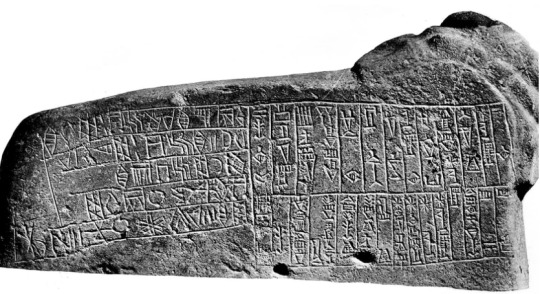
Bilingual Linear Elamite and Akkadian Inscription, parts of which were recently deciphered. Photo credit: Mission Archeologique en Iran
Ancient silver beakers from Iran may have just provided the key to a 120-year-old mystery going back 5,000 years. Headed by a French archaeologist from Tehran University, a group of European scholars has deciphered the symbols of an ancient script dubbed “Linear Elamite,” deepening scholarly understanding of the Kingdom of Elam. One of the oldest cultures in the world, it existed in Persia from the third millennium B.C.E. until it was conquered by the Persian Empire, which it assimilated into in the sixth century BCE.
The story begins in 1903, when French archaeologists excavated at ancient Susa, known in the Book of Esther as Shushan, in southwestern Iran. The excavations unearthed inscriptions in an unknown script. Later, it emerged that it was used by the Elamite culture in today’s southern Iran. Over the 20th century, researchers were able to decipher a small number of the Linear Elamite script’s symbols after a bilingual text was discovered written in Linear Elamite and Akkadian, which is a known script. Further efforts to decipher the inscriptions were stymied.
The current breakthrough was reported in a scientific article published in a German-language journal of Assyriology and the archaeology of the Near East, published in Berlin and considered a key platform in the field. One of the scholars involved in the research, the Assyriologist Prof. Gianni Marchesi of the University of Bologna, Italy, explained to Haaretz how the script was deciphered:

Decipherment of Linear Elamite Script. Photo credit: Mission Archeologique en Iran
“The Elamites used two different types of writing; the indigenous Linear Elamite script and the foreign cuneiform writing that had been imported from Mesopotamia.” Since cuneiform is well known to scholars, by reading the Elamite texts written in cuneiform, they were able to learn the names of Elamite kings and deities, Marchesi said.
The next stage was to examine texts in Linear Elamite to try to identify the names of those kings and deities, explained Dr. Peter Zilberg, of the department of Archaeology and Near Eastern Studies at the Hebrew University of Jerusalem.
“How could we do it?” Marchesi elaborated: "with a pinch of common sense, using the brain," I would say. For instance, there was a king named Puzur-Sushinak and a god named Insushinak: the two names partially overlap (their final parts coincide). This fact made it relatively easy to identify the sequences of signs of Linear Elamite corresponding to these two names; we just needed to find two sequences ending with the same group of signs…. So, from these two names we obtained the phonetic values of nine signs…which then could be used to identify other names and obtain additional phonetic values,” Marchesi said.
But how did they know for certain that these were the same names? There are only about 40 Linear Elamite inscriptions known in the world. To make sure they were comparing similar texts, the scholars selected Linear-Elamite texts that were likely to have been dedicatory inscriptions to Elamite kings and deities whose meanings were known in cuneiform.
The inscriptions in Linear Elamite were identified by Francois Desset, a French archaeologist in Iran, on beakers that found their way to a private collection in London to which he was given access.
Based on various tests, Desset posited that the vessels came from royal burial sites. He compared the texts inscribed on them to texts in Elamite written in cuneiform and on similar vessels. The assumption was that these two groups of texts would include dedications to the same rulers or have common elements (nouns, titles and nicknames) and similar expressions, the article in the German journal stated. The assumption was proven correct.
“A second step in the decipherment consisted in trying to identify, in Linear Elamite texts, not only proper nouns but also a number of phrases, clauses, and even sentences in the Elamite language that we knew from the Elamite texts written in cuneiform, under the assumption (proven true) that the two corpora of texts (Linear Elamite and cuneiform) should share the same phraseology,” Marchesi told Haaretz.
With painstaking work, the scholars were able to identify 72 symbols in Linear Elamite, which is believed to have between 80 and 110 symbols. “Hats off to them,” said Hebrew University Assyriologist Prof. Nathan Wasserman. “This was not ‘bingo’ nor the deciphering of a code in a romantic way, when suddenly everything becomes clear. As is often the case in the ancient world, it is about step after step,” Wasserman added.
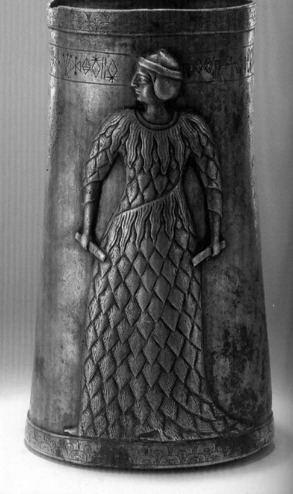
Silver Cup from Marvdasht, Iran, with a Linear Elamite Inscription from the time of Kutik-Inshushinak. National Museum of Iran. Photo Credit: Zereshk
According to scholars, Linear Elamite script is an important milestone in the development of script and languages worldwide. While cuneiform and hieroglyphics were common in Mesopotamia and Egypt, symbols representing whole words (logograms) were widely used. The Elamite script is basically phonetic, that is, its symbols represent vowels and consonants. Scholars consider it the most ancient alphabet of its kind, which is closer to the alphabet we have known since 1100 B.C.E. thanks to the Phoenicians.
Wasserman explained that the fact that a language of this type was found “at such an early stage – the end of the third millennium and beginning of the second millennium B.C.E. – is a major innovation in the world of languages altogether.” According to Wasserman, thanks to the new research “we have increased our ability to understand a very key culture in the Ancient Near East, about which we did not know much.”
Zilberg added that deciphering Linear Elamite script is fascinating in terms of the development of script and language, because this was a local, independent script that was “simply erased by other writing systems that swept the Ancient Near East.”
Still, a great deal of work lies ahead. Elamite was an independent language that is not associated with other languages, and so we cannot know how its words were pronounced, nor always understand their meaning. “When a language stands alone, it’s a difficult thing, because everything we know about it comes from the language itself,” Zilberg concluded.
“All the sisters or groups of this language disappeared, or didn’t board the script wagon in time,” Wasserman explained.
Source: https://www.haaretz.com/archaeology/2022-08-12/ty-article/.premium/mysterious-script-reveals-one-of-the-oldest-alphabets-in-the-world/00000182-8bd3-d9bc-affb-ebdf26270000
1 note
·
View note
Text
Conlanging Issues: A Compendium
NOTE: This question was submitted before the Nov 1, 2023 reopening and may not adhere to all rules and guidelines. The ask has been abridged for clarity.
Most of my questions are about linguistics. […] One of the major locations in my story is a massive empire with cultural inspirations ranging from North Africa in the far south to Mongolia/Russia in the far north […] The middle region is where the capital is and is the main root of culture, from which Ive been taking inspiration from Southwest Asia […], but most notably southern regions of India. I've tried to stick to the way cities are named in Sanskrit-based languages but added the names of stars to the front (because the prevalent religion of this region worships the stars [...]). So Ive ended up with names like Pavoprayag, Alyanaga, Alkaiduru, Alcorpura, Cygnapete, etc. Is this a consistent naming system or should I alter it in some way? The empire itself is named the Arcana Empire since [...] each act of my story is named after a tarot card [...].
Another region in my story is based more on parts of South China and North Vietnam, so I've tried to stick to names with a Chinese origin for that. I understand the significance of family names in southwest [sic] Asia, so I wanted to double check [...]. They have only two short given names. Based on the birth order of the child, the first half of the name comes from the fathers family and the second half from the mothers family. It is seen as disrespectful not to use both names because using only one is seen as denouncing that side of your family. Thus I have names like Su Yin, Dai Jun, and Yi Wen for some of the characters from this region, and the city itself that they are from is named Bei Fen.
On the other hand, Im having further trouble naming characters. […] Ive been trying to give my human characters names from real human cultures to distinguish them from the website-generated names of say, orcs, elves, dwarves, etc, but I think I should change many of the names Ive used to be more original and avoid fracturing real world cultures for the sake of my worldbuilding. […] Im still very weak in the linguistics area (even after four years of French, sigh) and am having trouble finding where to read about naming patterns so I can make new ones up. I read your naming guides but am still having trouble on where to start for specific languages. […] Im trying to look into Sanskrit, Turkish, and Persian specifically.
You're Going Too Broad
In my opinion, you’re casting too wide a net. You mentioned looking into Sanskrit, Turkish, and Persian to develop fantasy names. These languages are very different from one another, so unless you’re using them separately for very different parts of your world, it will be hard to draw inspiration from them in a way that makes sense. You’re taking on a huge amount of research in order to worldbuild cultures that span a massive geographical area (basically all of North Africa and Asia?) and have very little in common. Are you sure you want to take on that task?
I could see it being more manageable if most of your story is set in a small region of this world, which you will then research in depth to make sure you’re being as specific as possible.
Taking Persian as an example, you’ll have to decide whether you want to use Old Persian, Middle Persian, or Modern Persian. Each of these comes with a different alphabet and historical influences. They’re also associated with different periods of time and corresponding cultural and social markers. Once you’ve decided exactly when and where you want to start from, you can then expand the borders of your area of focus. For example, if you’ve decided to draw inspiration from Achaemenid Persia, you can then look at the languages that were spoken in the Achaemenid Empire. A quick Google search tells me that while Old Persian was the empire’s official language, they also used Aramaic, Akkadian, Median, Greek, and Elamite (among, I’m sure, many many others and many more regional variations). Further research into each of these will give you ethnic groups and bordering nations that you can draw more inspiration from to expand out your worldbuilding.
Don’t forget to make sure you’re staying within the same time period in order to keep things consistent. It’s a lot of work, and this is only for a small portion of the continent-spanning worldbuilding you’re trying to do.
You can get away with painting the rest of the continent in broad strokes without too much depth if the story doesn’t go there and you don’t have any main characters from those parts of the world. Otherwise, you’ll need to put this same level of detail into your worldbuilding for the area with Turkish-inspired names, and again for the area with Sanskrit-inspired names, and so on.
I know this isn’t what you were asking, but I honestly have a hard time helping you figure out where to start because your ask is so broad I don’t quite know where I would start myself. So, this is my advice: focus down on one region and time period and go from there. Feel free to write back once you’ve picked a narrower focus that we could help you with.
- Niki
So there’s logistical issues in regards to your naming system for southern China-coded regions. One issue is history: mainly on how there is not simply one language in China but multiple due to having a lot of ethnic groups and the size of China. South China in particular has different dialects and languages than the North as seen in this map of Chinese languages and dialects. There’s also how historically Mandarin was not the official language until 1913 in China and historical China saw vast changes in territory dependent on the dynasty. Before then, Mandarin was primarily a northern Chinese language based in Beijing while southern China had its own languages, dialects, and dynamics. Not to mention, historical China saw an evolution of language just like English has Old English, Middle English, Early Modern English, and Modern English. For instance, Vietnam was once part of China during the Tang Dynasty and at another point, it was not part of China.
-Mod Sci
If You’re Borrowing Whole Words or Elements, Research More
The other issue is inconsistency with the cultures you’re deriving this conlang from. In regards to “two given names,” the Chinese name I was given was one syllable and then I would have a last name that was also one syllable. There’s also how not every family is perfect. Not every marriage is sanctioned and some children may come from single parents. Some families may not cooperate with marriage and sometimes children may be abandoned with unknown parents. There does not seem to be contingencies for these names under this conlang system.
The main problem with conlangs is that one needs to truly understand the languages one is drawing from. Tolkein managed to create conlangs due to training in linguistics. Mandarin is already a difficult language with multiple tones, and trying to use it for conlangs without knowledge of how Mandarin works or a good foundation in linguistics is just a Sisyphean endeavor.
-Mod Sci
Four years of French wouldn’t have taught you about linguistics as a science or anything about the language families you’ve listed - Indo-Iranian, Sino-Tibetan, and Turkic, nor any Asian naming conventions. I agree with Niki that you need to narrow down your research.
Pur/pura means city in Sanskrit (ex: Gurdaspur, Hoshiarpur). Prayag is a place where pilgrimages are done. Naga isn’t a place name in Sanskrit (google says it means snake), nagar is and it means town. X Nagar is a very common name for places (Ex: Rajinder Nagar). Many cities in Karnataka have names ending in uru (Bengaluru, Mysuru, Mangaluru, Tumakuru, etc) but the language of Karnataka is Kannada - a Dravidian language and completely different family from Sanskrit (Indo-Aryan). I’m not sure where “pete” came from. “Bad” and “vaal” are common suffixes for places too (Ex: Faisalabad, Allahabad). A disclaimer that I do not speak Sanskrit, I speak Punjabi, which is a descendant of Sanskrit and in the same linguistic family (Indo-Aryan languages).
- SK
Also, This Is Not…Really Conlanging.
Hi OP. Linguistics refers to the science of studying how languages work, not the discipline of learning languages. And nothing shows that gap more than how you have thus far approached constructing fictional languages and toponyms.
The reason why Sci and SK have a lot to say about your place names is because they don't resonate—you have borrowed whole words into your toponyms (place names) from a variety of languages—without an accurate understanding of what these words mean, how they’re pronounced, where they’re derived from—and expected them to work together. I suggest you read the links below on why conlanging is not as simple as choosing some languages and mashing their IRL words together:
Why Using Random Languages Wholesale in your Fantasy is a Bad Idea
Pitfalls of Mashing Countries and Languages in Coding
In your city names, for example, you’re using star names from multiple languages that use different sets of sounds represented by different sets of historical spelling rules. “Cygn-” and “Arcana” stick out like a sore thumb—the fact that one “c” is /s/ and one is /k/ is an obvious flag that they are Latin-derived English borrowings. This is because spelling rules were created in Middle English to make sense of the mix of “c” pronunciations across words of Indo-European origin due to a historical split called the Centum-Satem division. This is a phenomenon that is very specific to our world history, and to the history of English at that. Ironically, in your attempt to avoid stock fantasy names (which also often fall into the Latin-derived English pit), you are taking the exact same approach to naming.
Like Niki said, your selections are far too broad to code under a single umbrella. Do you expect that whatever language that city name came from runs the full gamut of sound inventory & spelling variety that spans multiple continents and hundreds of languages? Because that’s not how languages work. (And yes, I mean hundreds. Indigenous languages and linguistic diversity are a thing. See Niki’s note about just the languages in Persia. And nation-states bulldozing over those languages and pretending it’s just one language is a thing. See Sci’s note about China.) I haven't even talked about the variation in morphology (how words are formed) or syntax (sentence structure).
Please just read or re-read my guide on “naming conlangs” in this post and start from there.
~ Rina
PSA ON CONLANGING AND FANTASY NAMES:
For fantasy language asks submitted after Nov 1, 2023, the asker must indicate that they have read Mod Rina’s conlanging posts linked in FAQ 2 (Guides and Posts by Topic) of the Masterpost under the question “How do I make a fictional language for my story?” While this is an older ask, we are posting it as an example to our followers.
Per our new rules, any questions that can be directly answered in or extrapolated from the FAQs, or questions that indicate that the relevant resources haven’t been read, will be deleted with a note in the Deletion Log explaining why.
As always, if this post was helpful or educational to you, please consider tipping the relevant mods: SK, Niki, Sci, and Rina.
Edited for terminology errors
321 notes
·
View notes
Text

Gate of All Nations
The Gate of Xerxes -UNESCO World Heritage
(r. 486 – 465 BC) Persepolis - IRAN
The bronze trumpets that once signaled the arrival of important foreign delegations to Persepolis, the ceremonial capital of the mighty Achaemenid Empire, may now be silent, but it is still possible to capture the sense of awe while visiting the colossal Gate of Xerxes.
Built during the reign of Achaemenid king Xerxes I , who called this his Gate of All Nations, the pillared entrance is guarded by bearded and hoofed mythical figures in the style of Assyrian gate-guards.
On arrival at Persepolis one is confronted by an imposing wall, completely smooth and plain, about 15 meters tall: this is the artificial terrace on which the palaces were built. This vast terrace of Persepolis, some 450 meters long and 300 meters wide, was originally fortified on three sides by a tall wall. The only access was from the monumental staircase, which leads to the Gate of All Nations.
The gateway bears a cuneiform inscription in Old Persian, Neo-Babylonian, and Elamite languages declaring, among other things, that Xerxes is responsible for the construction of this and many beautiful wonders in Persia. Centuries of graffitists have also left their mark, including explorer Henry Morton Stanley.
A pair of colossal bulls guarded the western entrance; two man-bulls stood at the eastern doorway. Engraved above each of the four colossi is a trilingual inscription attesting to Xerxes having built and completed the gate. The doorway on the south, opening toward the Apadana, is the widest of the three.
According to sources, pivoting devices found on the inner corners of all the doors indicate that they must have had two-leaved doors, which were probably made of wood and covered with sheets of ornamented metal.
Persepolis, also known as Takht-e Jamshid, whose magnificent ruins rest at the foot of Kuh-e Rahmat ("Mountain of Mercy"), was the ceremonial capital of the Achaemenid Empire. It is situated 60 kilometers northeast of the city of Shiraz in Fars Province.
Persepolis was the seat of the government of the Achaemenid Empire, though it was designed primarily to be a showplace and spectacular center for the receptions and festivals of the kings and their empire.
The royal city ranks among the archaeological sites which have no equivalent, considering its unique architecture, urban planning, construction technology, and art.
The city was burnt by Alexander in 330 BC apparently as revenge to the Persians
The immense terrace of Persepolis was begun about 518 BC by Darius the Great, the Achaemenid Empire’s king. On this terrace, successive kings erected a series of architecturally stunning palatial buildings, among them the massive Apadana palace and the Throne Hall (“Hundred-Column Hall”).
This 13-ha ensemble of majestic approaches, monumental stairways, throne rooms (Apadana), reception rooms, and dependencies is classified among the world’s greatest archaeological sites.
#art#design#doorway#architecture#heavensdoorways#gateway#entryway#iran#persepolis#bull#royal#royal city#style#history#gates of xerses#unesco world heritage#monumental#gate of all nations#achaemenid#persia#xerxes#front door#architrave
55 notes
·
View notes
Text
Countries that are no more: Achaemenid Empire (550BC-330BC)
It was not the first empire of Iranian peoples, but it arose as probably the greatest in terms of influence and became the measure by which all subsequent Iranian empires tended to compare themselves and its influence on culture, government & civil infrastructure would influence others beyond the span of its territory and the span of time. This is the Achaemenid Empire.
Name: In Old Persian it was known as Xšāça or the "The Kingdom or the Empire", it was named the Achaemenid Empire by later historians. Named after the ruling dynasty established by its founder Cyrus the Great who cited the name of his ancestor Haxāmaniš or Achaemenes in Greek as progenitor of the dynasty. It is sometimes also referred to as the First Persian Empire. The Greeks simply referred to it as Persia, the name which stuck for the geographic area of the Iranian plateau well into the modern era.
Language: Old Persian & Aramaic were the official languages. With Old Persian being an Iranian language that was the dynastic language of the Achaemenid ruling dynasty and the language of the Persians, an Iranian people who settled in what is now the southwestern Iranian plateau or southwest Iran circa 1,000 BC. Aramaic was a Semitic language that was the common and administrative language of the prior Neo-Assyrian & Neo-Babylonian Empires which centered in Mesopotamia or modern Iraq, Syria & Anatolian Turkey. After the Persian conquest of Babylon, the use of Aramaic remained the common tongue within the Mesopotamian regions of the empire, eventually becoming a lingua franca across the land. As the empire spread over a vast area and became increasingly multiethnic & multicultural, it absorbed many other languages among its subject peoples. These included the Semitic languages Akkadian, Phoenician & Hebrew. The Iranian language of Median among other regional Iranian languages (Sogdian, Bactrian etc). Various Anatolian languages, Elamite, Thracian & Greek among others.
Territory: 5.5 million kilometers squared or 2.1 million square miles at its peak circa 500BC. The Achaemenid Empire spanned from southern Europe in the Balkans (Greece, Bulgaria, European Turkey) & northwest Africa (Egypt, Libya & Sudan) in the west to its eastern stretches in the Indus Valley (Pakistan) to parts of Central Asia in the northeast. It was centered firstly in the Iranian Plateau (Iran) but also held capitals in Mesopotamia (Iraq). Territory was also found in parts of the Arabian Peninsula & the Caucausus Mountains.
Symbols & Mottos: The Shahbaz or Derafsh Shahbaz was used as the standard of Cyrus the Great, founder of the empire. It depicts a bird of prey, typically believed to be a falcon or hawk (occasionally an eagle) sometimes rendered gold against a red backdrop and depicts the bird holding two orbs in its talons and adorned with an orb likewise above its head. The symbolism was meant to depict the bird guiding the Iranian peoples to conquest and to showcase aggression & strength coupled with dignity. The imperial family often kept falcons for the pastime of falconry.
Religion: The ancient Iranian religion of Zoroastrianism served as the official religion of the empire. It was adopted among the Persian elite & and had its unique beliefs but also helped introduce the concept of free-will among its believers, an idea to influence Judaism, Christianity & Islam in later centuries. Despite this official religion, there was a tolerance for local practices within the subject regions of the empire. The ancient Mesopotamian religion in Babylon & Assyria, Judaism, the Ancient Greek & Egyptian religions & Vedic Hinduism in India was likewise tolerated as well. The tolerance of the Achaemenids was considered a relative hallmark of their dynasty from the start. Famously, in the Old Testament of the Bible it was said that it was Cyrus the Great who freed the Jews from their Babylonian captivity and allowed them to return to their homeland of Judea in modern Israel.
Currency: Gold & silver or bimetallic use of coins became standard within the empire. The gold coins were later referred to as daric and silver as siglos. The main monetary production changes came during the rule of Darius I (522BC-486BC). Originally, they had followed the Lydian practice out of Anatolia of producing coins with gold, but the practice was simplified & refined under the Achaemenids.
Population: The estimates vary ranging from a low end of 17 million to 35 million people on the upper end circa 500BC. The official numbers are hard to determine with certainty but are generally accepted in the tens of millions with the aforementioned 17-35 million being the most reasonable range based on available sources.
Government: The government of the Achaemenid Empire was a hereditary monarchy ruled by a king or shah or later referred to as the ShahanShah or King of Kings, this is roughly equivalent to later use of the term Emperor. Achaemenid rulers due the unprecedented size of their empire held a host of titles which varied overtime but included: King of Kings, Great King, King of Persia, King of Babylon, Pharaoh of Egypt, King of the World, King of the Universe or King of Countries. Cyrus the Great founded the dynasty with his conquest first of the Median Empire and subsequently the Neo-Babylonians and Lydians. He established four different capitals from which to rule: Pasargadae as his first in Persia (southwest central Iran), Ecbatana taken from the Medians in western Iran's Zagros Mountains. The other two capitals being Susa in southwest Iran near and Babylon in modern Iraq which was taken from the Neo-Babylonians. Later Persepolis was made a ceremonial capital too. The ShahanShah or King of Kings was also coupled with the concept of divine rule or the divinity of kings, a concept that was to prove influential in other territories for centuries to come.
While ultimate authority resided with the King of Kings and their bureaucracy could be at times fairly centralized. There was an expansive regional bureaucracy that had a degree of autonomy under the satrapy system. The satraps were the regional governors in service to the King of Kings. The Median Empire had satraps before the Persians but used local kings they conquered as client kings. The Persians did not allow this because of the divine reverence for their ShahanShah. Cyrus the Great established governors as non-royal viceroys on his behalf, though in practice they could rule like kings in all but name for their respective regions. Their administration was over their respective region which varied overtime from 26 to 36 under Darius I. Satraps collected taxes, acted as head over local leaders and bureaucracy, served as supreme judge in their region to settle disputes and criminal cases. They also had to protect the road & postal system established by the King of Kings from bandits and rebels. A council of Persians were sent to assist the satrap with administration, but locals (non-Persian) could likewise be admitted these councils. To ensure loyalty to the ShahanShah, royal secretaries & emissaries were sent as well to support & report back the condition of each satrapy. The so called "eye of the king" made annual inspections of the satrapy to ensure its good condition met the King of Kings' expectations.
Generals in chief were originally made separate to the satrap to divide the civil and military spheres of government & were responsible for military recruitment but in time if central authority from the ShahanShah waned, these could be fused into one with the satrap and general in chiefs becoming hereditary positions.
To convey messages across the widespread road system built within the empire, including the impressive 2,700 km Royal Road which spanned from Susa in Iran to Sardis in Western Anatolia, the angarium (Greek word) were an institution of royal messengers mounted on horseback to ride to the reaches of the empire conveying postage. They were exclusively loyal to the King of Kings. It is said a message could be reached to anywhere within the empire within 15 days to the empire's vast system of relay stations, passing message from rider to rider along its main roads.
Military: The military of the Achaemenids consisted of mostly land based forces: infantry & cavalry but did also eventually include a navy.
Its most famous unit was the 10,000-man strong Immortals. The Immortals were used as elite heavy infantry were ornately dressed. They were said to be constantly as 10,000 men because for any man killed, he was immediately replaced. Armed with shields, scale armor and with a variety of weapons from short spears to swords, daggers, slings, bows & arrows.
The sparabara were the first line of infantry armed with shields and spears. These served as the backbone of the army. Forming shield walls to defend the Persian archers. They were said to ably handle most opponents and could stop enemy arrows though their shields were vulnerable to enemy spears.
There was also the takabara light infantry and though is little known of them it seems they served as garrison troops and skirmishers akin to the Greek peltast of the age.
The cavalry consisted of four distinct groups: chariot driven archers used to shoot down and break up enemy formations, ideally on flat grounds. There was also the traditional horse mounted cavalry and also camel mounted cavalry, both served the traditional cavalry functions and fielded a mix of armor and weapons. Finally, there was the use of war elephants which were brought in from India on the empire's eastern reaches. These provided archers and a massive way to physically & psychologically break opposing forces.
The navy was utilized upon the empire's reaching the Mediterranean and engaged in both battles at sea and for troop transport to areas where troops needing deploying overseas, namely in Greece.
The ethnic composition of Achaemenid military was quite varied ranging from a Persian core with other Iranian peoples such as the Medians, Sogdian, Bactrians and Scythians joining at various times. Others including Anatolians, Assyrians, Babylonians, Anatolians, Indians, Arabs, Jews, Phoenicians, Thracians, Egyptians, Ethiopians, Libyans & Greeks among others.
Their opponents ranged from the various peoples they conquered starting with the Persian conquest of the Medians to the Neo-Babylonians, Lydians, Thracians, Greeks, Egyptians, Arabs & Indians and various others. A hallmark of the empire was to allow the local traditions of subjugated areas to persist so long as garrisons were maintained, taxes were collected, local forces provided levies to the military in times of war, and they did not rebel against the central authority.
Economy: Because of the efficient and extensive road system within the vast empire, trade flourished in a way not yet seen in the varied regions it encompassed. Tax districts were established with the satrapies and could be collected with relative efficiency. Commodities such as gold & jewels from India to the grains of the Nile River valley in Egypt & the dyes of the Phoenicians passed throughout the realm's reaches. Tariffs on trade & agricultural produce provided revenue for the state.
Lifespan: The empire was founded by Cyrus the Great circa 550BC with his eventual conquest of the Median & Lydian Empires. He started out as Cyrus II, King of Persia a client kingdom of the Median Empire. His reign starting in 559BC. Having overthrown and overtaken the Medians, he turned his attention Lydia and the rest of Anatolia (Asia Minor). He later attacked the Eastern Iranian peoples in Bactria, Sogdia and others. He also crossed the Hindu Kush mountains and attacked the Indus Valley getting tribute from various cities.
Cyrus then turned his attention to the west by dealing with the Neo-Babylonian Empire. Following his victory in 539BC at the Battle of Opis, the Persians conquered the Babylonia with relative quickness.
By the time of Cyrus's death his empire had the largest recorded in world history up to that point spanning from Anatolia to the Indus.
Cyrus was succeeded by his sons Cambyses II and Bardiya. Bardiya was replaced by his distant cousin Darius I also known as Darius the Great, whose lineage would constitute a number of the subsequent King of Kings.
Darius faced many rebellions which he put down in succession. His reign is marked by changes to the currency and the largest territorial expansion of the empire. An empire at its absolute zenith. He conquered large swaths of Egypt, the Indus Valley, European Scythia, Thrace & Greece. He also had exploration of the Indian Ocean from the Indus River to Suez Egypt undertaken.
The Greek kingdom of Macedon in the north reaches of the Hellenic world voluntarily became a vassal of Persia in order to avoid destruction. This would prove to be a fateful first contact with this polity that would in time unite the Greek-speaking world in the conquest of the Achaemenid Empire. However, at the time of Darius I's the reign, there were no early indications of this course of events as Macedon was considered even by other Greek states a relative backwater.
Nevertheless, the Battle of Marathon in 490BC halted the conquest of mainland Greece for a decade and showed a check on Persia's power in ways not yet seen. It is also regarded as preserving Classical Greek civilization and is celebrated to this day as an important in the annals of Western civilization more broadly given Classical Greece & in particular Athens's influence on western culture and values.
Xerxes I, son of Darius I vowed to conquer Greece and lead a subsequent invasion in 480BC-479BC. Xerxes originally saw the submission of northern Greece including Macedon but was delayed by the Greeks at the Battle of Thermopylae, most famously by Spartan King Leonidas and his small troop (the famed 300). Though the Persians won the battle it was regarded as a costly victory and one that inspired the Greeks to further resistance. Though Athens was sacked & burnt by the Persians, the subsequent victories on sea & land at Salamis & Plataea drove the Persians back from control over Greece. Though war would rage on until 449BC with the expulsion of the Persians from Europe by the Greeks.
However, the Greeks found themselves in a civil war between Athens & Sparta and Persia having resented the Athenian led coalition against their rule which had expelled them from Europe sought to indirectly weaken the Greeks by supporting Greek factions opposed to Athens through political & financial support.
Following this reversal of fortune abroad, the Achaemenid Empire not able to regain its foothold in Europe, turned inward and focused more on its cultural development. Zoroastrianism became the de-facto official religion of the empire. Additionally, architectural achievements and improvements in its many capitals were undertaken which displayed the empire's wealth. Artaxerxes II who reigned from 405BC-358BC had the longest reign of any Achaemenid ruler and it was characterized by relative peace and stability, though he contended with a number of rebellions including the Great Satraps Revolt of 366BC-360BC which took place in Anatolia and Armenia. Though he was successful in putting down the revolt. He also found himself at war with the Spartans and began to sponsor the Athenians and others against them, showcasing the ever dynamic and changing Greco-Persian relations of the time.
Partially for safety reasons, Persepolis was once again made the capital under Artaxerxes II. He helped expand the city and create many of its monuments.
Artaxerxes III feared the satraps could no longer be trusted in western Asia and ordered their armies disbanded. He faced a campaign against them which suffered some initial defeats before overcoming these rebellions, some leaders of which sought asylum in the Kingom of Macedon under its ruler Philip II (father of Alexander the Great).
Meanwhile, Egypt had effectively become independent from central Achaemenid rule and Artaxerxes III reinvaded in around 340BC-339BC. He faced stiff resistance at times but overcame the Egyptians and the last native Egyptian Pharaoh Nectanebo II was driven from power. From that time on ancient Egypt would be ruled by foreigners who held the title Pharaoh.
Artaxerxes III also faced rebellion from the Phoenicians and originally was ejected from the area of modern coastal Lebanon, Syria & Israel but came back with a large army subsequently reconquered the area including burning the Phoenician city of Sidon down which killed thousands.
Following Artaxerxes III's death his son succeeded him but a case of political intrigue & dynastic murder followed. Eventually Darius III a distant relation within the dynasty took the throne in 336BC hoping to give his reign an element of stability.
Meanwhile in Greece, due to the military reforms and innovations of Philip II, King of Macedon, the Greek speaking world was now unified under Macedon's hegemony. With Philip II holding the title of Hegemon of the Hellenic League, a relatively unified coalition of Greek kingdoms and city-states under Macedon premiership that formed to eventually invade Persia. However, Philip was murdered before his planned invasion of Asia Minor (the Achaemenid's westernmost territory) could commence. His son Alexander III (Alexander the Great) took his father's reforms and consolidated his hold over Greece before crossing over to Anatolia himself.
Darius III had just finished reconquering some rebelling vestiges of Egypt when Alexander army crossed over into Asia Minor circa 334BC. Over the course of 10 years Alexander's major project unfolded, the Macedonian conquest of the Persian Empire. He famously defeated Persians at Granicus, Issus and Gaugamela. The latter two battles against Darius III in person. He took the King of Kings family hostage but treated them well while Darius evacuated to the far eastern reaches of his empire to evade capture. He was subsequently killed by one of his relatives & satraps Bessus, whom Alexander eventually had killed. Bessus had declared himself King of Kings though this wasn't widely recognized and most historians regard Darius III, the last legitimate ShahanShah of Achaemenids.
Alexander had taken Babylon, Susa & Persepolis by 330BC and effectively himself was now ruler of the Persian Empire or at least its western half. In addition to being King of Macedon & Hegemon of the Hellenic League, he gained the titles King of Persia, Pharaoh of Egypt & Lord of Asia. Alexander would in time eventually subdue the eastern portions of the Achaemenid realm including parts of the Indus Valley before turning back to Persia and Babylon where he subsequently became ill and died in June 323BC at age 32. Alexander's intentions it appears were never to replace the Achaemenid government & cultural structure, in fact he planned to maintain and hybridize it with his native Greek culture. He was in fact an admirer of Cyrus the Great (even restoring his tomb after looting) & adopted many Persian customs and dress. He even allowed the Persians to practice their religion and had Persian and Greeks start to serve together in his army. Following his death and with no established successor meant the empire he established which essentially was the whole Achaemenid Empire's territory in addition to the Hellenic world fragmented into different areas run by his most trusted generals who established their own dynasties. The Asian territories from Anatolia to the Indus (including Iran and Mesopotamia) gave way to the Hellenic ruled Seleucid Empire while Egypt became the Hellenic ruled Ptolemaic Kingdom. The synthesis of Persian and Greek cultures continued in the Seleucid and Greco-Bactrian kingdoms of antiquity.
The Achaemenid Empire lasted for a little over two centuries (550BC-330BC) but it casted a long shadow over history. Its influence on Iran alone has persisted into the modern age with every subsequent Persian Empire claiming to be its rightful successor from the Parthian & Sasanian Empires of pre-Islamic Iran to the Safavids of the 16th-18th century and the usage of the title Shah until the last Shah's ejection from power in the 1979 Islamic Revolution. Even the modern Islamic Republic of Iran uses Achaemenid imagery in some military regiments and plays up its importance in tourism and museums as a source of pride to Persian (Farsi) & indeed Iranian heritage. Likewise, its form of governance and the pushing of the concept of divine rights of kings would transplant from its Greek conquerors into the rest of Europe along with various other institutions such as its road & mail system, tax collection & flourishing trade. Its mix of centralized & decentralized governance. Its religious & cultural tolerance of local regions even after their conquest would likewise serve as a template for other empires throughout history too. The Achaemenid Empire served as a template for vast international & transcontinental empires that would follow in its wake & surpass its size & scope of influence. However, it is worth studying for in its time, it was unprecedented, and its innovations so admired by the likes of Alexander the Great and others echo into the modern era.
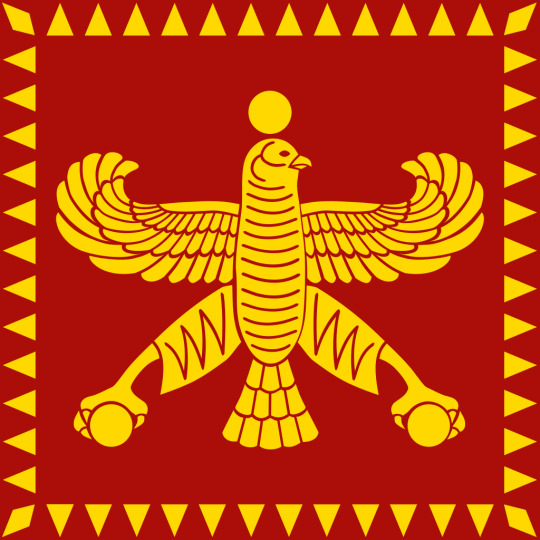
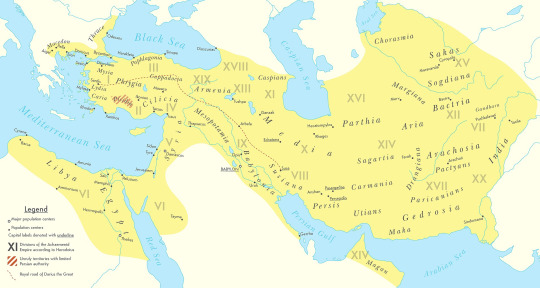


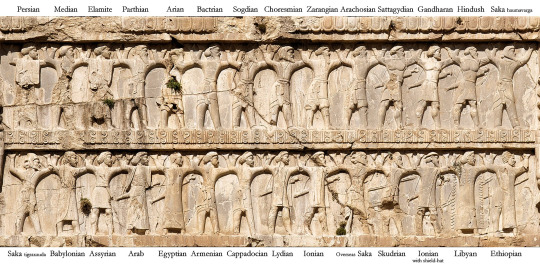
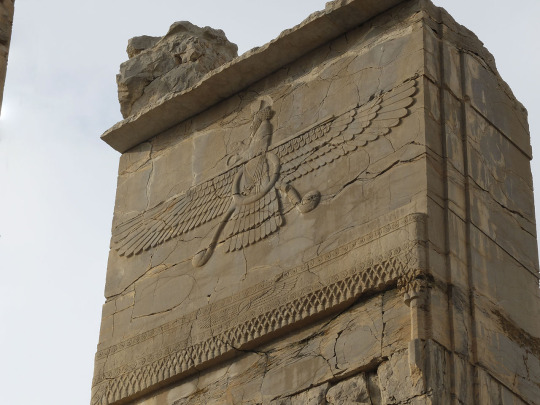




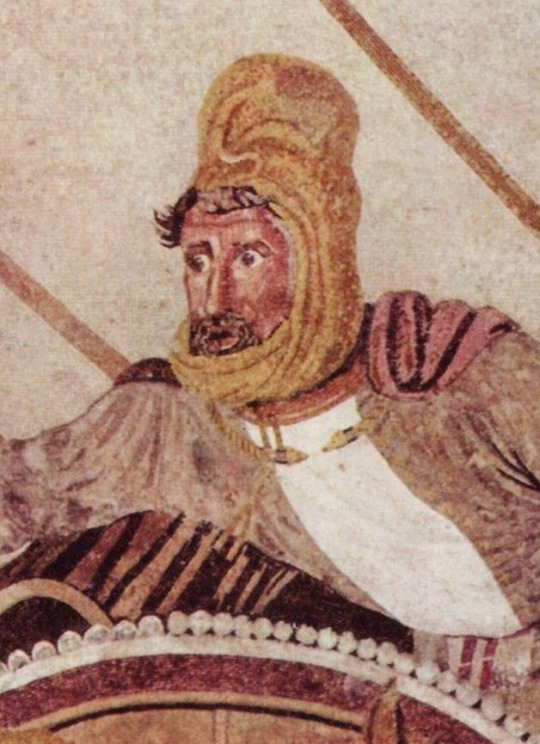
#military history#antiquity#iran#greece#ancient greece#classical greece#ancient ruins#ancient iran#ancient persia#achaemenid#persia#zoroastrianism#alexander the great#cyrus the great#xerxes#artwork#government#history#persian empire#ancient egypt
93 notes
·
View notes
Text
Submitted via Google Form:
What is the earliest point in evolution could humans evolve written language? Let's say biologically, human evolution was similar to reality, could say Neanderthals have written language already? Like before civilisations began? Also, written language is certainly not only for the elite. In fact, it got started in various families and then got spread among the tribes. So we have thousands of different tribes and familes across the world - each with their own languages and writing systems. Of course, there are some similarities as people have travelled a bit and met neighbouring tribes. So basically before society was properly formed into civilisations, there should already be writing but civilisation is actually what prodded society to centralise communications and languages. Does this work? Basically, I just want a society that had writing from much earlier on than reality and figuring out how it could have been done.
Tex: Writing is developed, much like any other tool, as a function of necessity. If it’s not necessary for a society to develop it, then writing won’t exist for them. Civilisation is also, as a concept, prone to periodic re-defining as we accumulate more data and our perceptions of the data shift (for example, one could define the pinnacle of civilisation as taxes, where before another defined it as religion).
Writing also has exceptionally little to do with biology as writing is a social construct meant to fill a void found in one’s culture. Consequentially, writing can also encompass a broad range of intentional markings that demonstrate specific meanings, from tally marks, to standardized pictures, to ideograms, to glyphs.
What does your world need writing for? What niche does it fill? What were the people using as its predecessor, and what happened to cause them to change systems? Did the scope of their needs change, or did the perception of their needs change? What information is important for them to record, on a societal and personal level? Who teaches writing? Who learns it? What is the method of transmission, and for those that teach writing, is it their sole occupation or something on the side?
Utuabzu: Writing is old. Really old. At least 5000 years old. This seems a long time, but humans have been living in permanent settlements and practicing forms of agriculture in West Asia for about 9000 years. Homo sapiens has been around for at least 300,000 years. But only in the last few thousand years, in a handful of places, did humans independently come up with the idea that the spoken word could be preserved using symbols that others could be trained to decipher.
The earliest writing as far as we can tell is cuneiform, from Sumeria in what is now southern Iraq. It may or may not have had some influence on the development of Egyptian hieroglyphs from pictographs to an actual script - we have found Sumerian cylinder seals in very early Egyptian sites, indicating that the two groups were in contact. But from these two points the idea of writing spread through the Mediterranean and West Asia. The Indus Valley civilisation also used a script, but we are unable to decipher it and have relatively few examples to work from, so we cannot tell if it even is a true script or if it predates contact with Sumeria.*
Shang Dynasty China also developed the earliest form of Chinese script from the Oracle Bone tradition not long after this. This also spread, together with Chinese ideas, agricultural and governmental practices across much of eastern Asia.
Meanwhile cuneiform script was adopted by a wide range of cultures in West Asia, and inspired other scripts like Elamite, Old Persian and Ugaritic, which while using similar shapes were structured very differently. Egyptian hieroglyphs inspired Anatolian hieroglyphs and were later in the early Iron Age the basis that the Phoenician alphabet** - ancestor of alphabetic, abjad and abugida scripts from the Philippines to Iceland - was derived from.
Another place we see writing develop entirely independently is in Central America, where a pictographic system was employed from the Olmec period all the way through to the 16th Century, but only became a true script in the Mayan region [at time, need to check when]. The system employed elsewhere in Mesoamerica did not have the capacity to accurately render speech, so far as we are aware.***
There are also a handful of other instances that might or might not be examples of true scripts developing entirely independently, from rorotongo on Rapanui to the quipus of the Andes to [pretty sure there's one in central africa, but can't remember the name just now]. We simply don't have enough information to be certain about any of them. Oftentimes, because the media they were written on does not survive all that well, or was deliberately destroyed.
But something you should bear in mind is that complex societies don't necessarily require writing for a lot of their history. Many of the most impressive cultures of the ancient world were not widely or at all literate. There's no indication that the Mississippian culture that built sites like Cahokia had writing, nor did Teotihuacán or the various cultures of the Andes. There's no evidence of writing at Great Zimbabwe, nor at Jomon sites in Japan.
Even in cultures that did have writing, it was frequently not a widely known skill. Your average ancient Egyptian couldn't read hieroglyphs, and Chinese hanzi still take years to master. This is part of why so many traditional scripts were displaced in the 19th and early 20th century. Most people couldn't read them and when authorities decided to use Roman or Cyrillic or something else in mass education, it very quickly became much more widely understood than the traditional script.
To my knowledge, there's no examples of a pre-agricultural society developing writing independently. Some have derived scripts from those they came into contact with, or made entirely unique ones inspired by writing they knew of. But so far as I am aware, none have ever created a script entirely from scratch with no prior exposure to the concept of writing.
*the Sumerians appear to have called the Indus Valley Civilisation 'Meluhha', and were actively trading with it from at least the Bronze Age. Ur III records even tell of a colony of Meluhha merchants at Guabba, near Lagaš, and Sumerian cylinder seals have been found in Indus Valley sites.
**actually an abjad.
*** the conquistadors burned almost all pre Columbian codices, so we can't ever be 100% certain that no other variants of the system developed into true scripts. But it's unlikely.
23 notes
·
View notes
Photo

Semitic Languages
The Semitic languages are a branch of the Afroasiatic language family. They are spoken by more than 330 million people across much of West Asia, the Horn of Africa, and latterly North Africa, Malta, West Africa, and in large immigrant and expatriate communities in North America, Europe, and Australasia. The terminology was first used in the 1780s by members of the Göttingen school of history, who derived the name from Shem, one of the three sons of Noah in the Book of Genesis.
Semitic languages occur in written form from a very early historical date in West Asia, with East Semitic Akkadian and Eblaite texts (written in a script adapted from Sumerian cuneiform) appearing from the 30th century BCE and the 25th century BCE in Mesopotamia and the north eastern Levant respectively. The only earlier attested languages are Sumerian, Elamite (2800 BCE to 550 BCE), both language isolates, and Egyptian (a sister branch of the Afroasiatic family, related to the Semitic languages but not part of them). Amorite appeared in Mesopotamia and the northern Levant circa 2000 BC, followed by the mutually intelligible Canaanite languages (including Hebrew, Phoenician, Moabite, Edomite and Ammonite, and perhaps Ekronite, Amalekite and Sutean), the still spoken Aramaic, and Ugaritic during the 2nd millennium BC.
358 notes
·
View notes
Text
Basic misconceptions about Mesopotamian mythology
Most of the so-called “Sumerian mythology” is simply the school curriculum of Old Babylonian scribes who did not speak Sumerian as a vernacular anymore, it’s a misnomer, sort of like calling medieval European copies of the Bible written in Latin “Latin mythology” would be. Sumerian is chiefly a language, not a religion.
It is difficult to tell if there ever was a full separation between “Sumerian” and “Akkadian” pantheons since even in the linguistically “most Sumerian” Lagash deities with Akkadian names were worshiped since the dawn of recorded history, most notably Ishtaran. There were also areas where Mesopotamian deities were basically mixed with Hurrian (Arrapha = modern Kirkuk) or Elamite (Susa and the “Elamite lowlands”) ones.
“Seven gods who decree” were largely invented by early Assyriologists who wanted a coherent, self-contained pantheon. In reality the composition of the top of the pantheon varied by both time period and location and rarely, if ever, the gods on top were seven in number.
Multiple deities early authors like Kramer or Jacobsen didn’t even bother to write about can easily count as “major,” for example Ishtaran or Nanaya.
Mesopotamian gods did not necessarily embody forces of nature nor was being related to a specific force of nature a prerequisite for being a major deity. In fact, some of the most major ones were tied to activities directly tied to organized society, like specific cities, medicine or scribal arts. Many deities who have nothing to do with nature are already attested in the oldest documents, too, for example the metalworker goddess Ninmug.
There are multiple works of literature older than Epic of Gilgamesh. Literally dozens.
Enuma Elish being treated as some grand central text of Mesopotamian mythology is kind of as if one tried to gain full understanding of Greek mythology by centering the declaration of deification of a single Roman emperor. Also, Tiamat is virtually absent from Mesopotamian texts otherwise.
It is physically impossible to draw a single family tree of Mesopotamian gods and in at least some cases new ancestors were invented specifically to avoid divine incest (confirmed by Wilfred G. Lambert). There are multiple deities with no genealogy to speak of, including regional gods, spouses of most major deities and divine courtiers. The genealogy of many deities was variable, too.
This being said - Nanna(/Suen) and Ningal being parents of Inanna was the default, not a variant tradition. Epic of Gilgamesh is an outlier in not following this view. Such was the power of this tradition that foreign deities treated as analogous to Inanna/Ishtar were assigned as children to corresponding moon gods... or just outright “borrowed” Nanna and Ningal as parents, as in the case of Pinikir.
The names Inanna and Ishtar more or less variably designated the goddess of Uruk, but there were other, not necessarily fully identical goddesses sharing these names - Inanna of Zabalam (that’s the one with a son, not Inanna of Uruk), Ishtar of Kish, “Ishtar” of Nineveh (in reality Hurrian Shaushka) and more. There were also multiple medicine goddesses. Many recent studies (1990s onward) generally emphasize the differences instead of lumping them together.
Inanna was not blamed for Dumuzi’s death in most compositions dealing with it.
Queen Kubaba has nothing to do with the similarly named goddess from northern Syria.
231 notes
·
View notes
Text
7 undeciphered writing systems
(While reading, remember that it’s possible to decipher a script and still not understand the language that the script represents.)
(Each heading links to that script's respective Wikipedia page.)
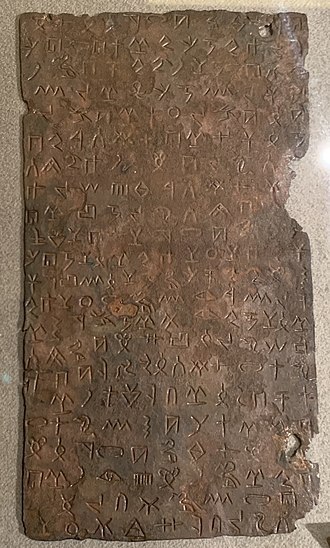
Byblos Syllabary
The Byblos syllabary is attested in 10 inscriptions found in Byblos, a coastal city in Lebanon. It likely represents a Semitic language, but despite a handful of attempts at decipherment, there still isn’t a consensus as to what sound each character represents.
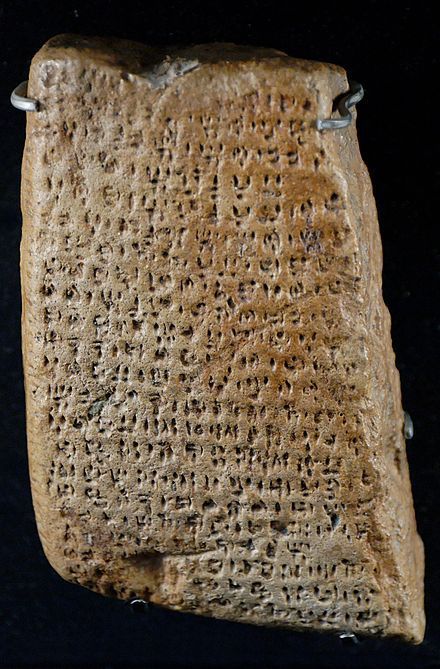
Cypro-Minoan Syllabary
The Cypro-Minoan syllabary appears on ~250 objects—especially clay balls and cylinders that were used for recording economic transactions—on the island of Cyprus.
The script suddenly disappears in 950 BCE and was replaced by the Cypriot syllabary, which was used to write Greek, and based on Cypro-Minoan. This evolution allows us to infer the sounds of some of the signs in Cypro-Minoan, but we still don’t know what language it represented—probably either Minoan or Eteocypriot.
There are only ~2,500 total instances of signs for Cypro-Minoan, which is significantly less than Linear B when it was deciphered (~30,000).
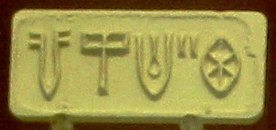
Indus Valley Script
The Indus Valley script is known from ~4,000 objects with very short inscriptions found in and around the Indus Valley, and represents the Harappan language (the unknown language of the Indus Valley civilization).
It has about 400 distinct signs, which is too many for each sign to represent a single sound or syllable, but too few for each sign to represent a word. Scholars thus think the system is logo-syllabic (basically a mix of the two).
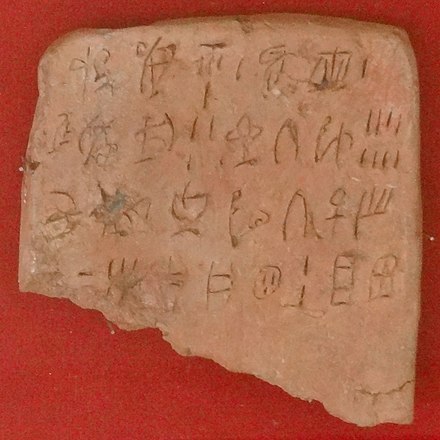
Linear A
Linear A: Everybody’s favorite mysterious undeciphered script. Linear A was used by the Minoans on the island of Crete, and is called “linear” because the script is written by cutting lines into clay, rather than pressing wedges into clay like cuneiform.
Linear A was adapted to write Mycenean Greek and became Linear B (deciphered in the 1950s), and because of this we can infer many of the sound values of symbols in Linear A. However, 80% of Linear A’s signs are unique, not shared with Linear B.
Linear A itself probably developed from the earlier Cretan hieroglyphs, which are also undeciphered.
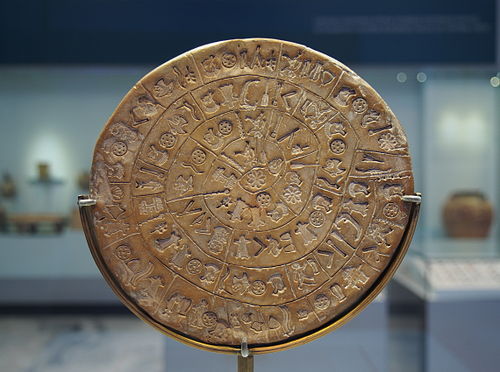
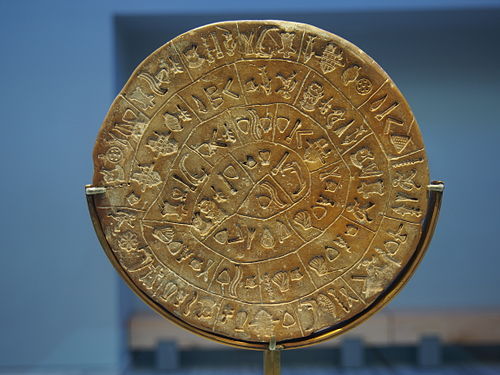
Phaistos Disk
The Phaistos Disk. Also from the Minoan civilization on Crete, yet seemingly unrelated to Linear A. This disk is the only certain attestation of this (assumed) script, spiraling around both sides. There are 242 tokens comprising 45 distinct signs.
The Phaistos Disk also happens to be an early example of moving type printing, since each character was made by pressing seals into clay.
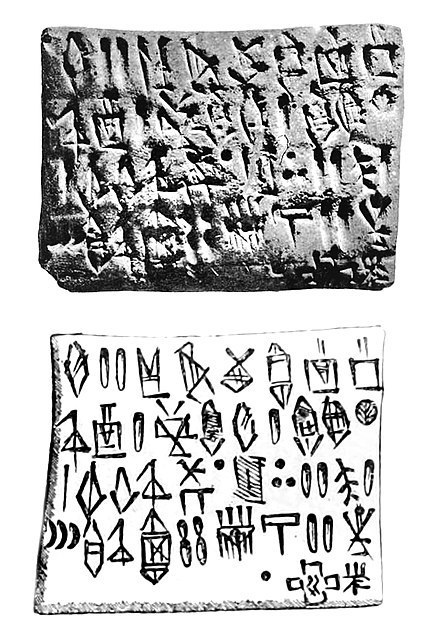
Proto-Elamite
The Proto-Elamite script developed alongside Proto-Cuneiform, and was used for similar functions and in similar ways until it was replaced by cuneiform. Proto-Elamite, like cuneiform, began as a system of marking tokens and spheres with details of economic transactions.

Rongorongo
Rongorongo is a system of glyphs used on Rapa Nui (Easter Island), found only on about two dozen wooden objects. According to oral history, the tablets were considered sacred, and only a small elite class could read them. Unfortunately, that tradition was wiped out after slaving raids and epidemics caused the collapse of Rapa Nui society.
Though the glyphs, if they are writing, undoubtedly represent the Rapa Nui language, little is known about it because modern Rapa Nui has had heavy influence from Tahitian.
---
Want to learn more about the world’s writing systems and their history? Check out my curated list of books on Writing & Writing Systems!
452 notes
·
View notes
Text
On the topic of Speaking in tongues
When I had just found God I was in university in Scotland. I was on fire for God even though I really didn't know anything. I'm grateful God found me. I studied theology and met young people from all over the world and we formed a little community. We were from different denominations and from different backgrounds. Some of us came from very christian backgrounds, some of us were from less christian backgrounds. It was fun to discuss religion! And it was fun to pray with different people. Especially for me who had just found Christ.
...and that's when I found myself praying with a girl from Kazakhstan. She was very cool. Exmuslim, had found Christ and defied her parents. Very mentally strong. She had several bibles with passages highlighted and I could tell she was trying to teach me. It was nice. Until she took my hands, closed her eyes and started praying. It started normally with words in English. Then it switched over to nonsense words. She was from the pentecostal church. I found it very strange, I remember opening my eyes and just looking at her. After the praying was done, she told me that it was praying words you don't understand because it's a divine language. Me, who didnt know anything, thought she was right. So the following days I tried to pray like that. But my heart is too traditionally Lutheran to manage.
Now that I'm older and - God help me - wiser I no longer believe that talking in tongues the way that the pentecostal church does is a thing. Tongues means language, like English, Swedish, Arabic etc. If I can bring your attention to The Book of Acts chapter 2:
The Holy Spirit Comes at Pentecost
2 When the day of Pentecost came, they were all together in one place. 2 Suddenly a sound like the blowing of a violent wind came from heaven and filled the whole house where they were sitting. 3 They saw what seemed to be tongues of fire that separated and came to rest on each of them. 4 All of them were filled with the Holy Spirit and began to speak in other tongues[a] as the Spirit enabled them.
5 Now there were staying in Jerusalem God-fearing Jews from every nation under heaven. 6 When they heard this sound, a crowd came together in bewilderment, because each one heard their own language being spoken. 7 Utterly amazed, they asked: “Aren’t all these who are speaking Galileans? 8 Then how is it that each of us hears them in our native language?" 9 Parthians, Medes and Elamites; residents of Mesopotamia, Judea and Cappadocia, Pontus and Asia,[b] 10 Phrygia and Pamphylia, Egypt and the parts of Libya near Cyrene; visitors from Rome 11 (both Jews and converts to Judaism); Cretans and Arabs—we hear them declaring the wonders of God in our own tongues!” 12 Amazed and perplexed, they asked one another, “What does this mean?”
Above it says that when The Holy Spirit entered them they started speaking in different tongues. At that time there were Jews from all over the world there and they understood what the apostles were saying. The human Jews understood what the early Christians were saying. If it had been words that no humans could understand it wouldn't have been so.
They even ask "Aren’t all these who are speaking Galileans? Then how is it that each of us hears them in our native language?" Which again they would only ask if they could understand what was being said.
It's a huge miracle that the Galileans could suddenly speak languages of the world that they had never spoken before! And that's that in my head.
...thanks for reading!
#jesus#christian#bible#christianity#christian living#bible quote#lgbt christian#jesus christ#queer christian#god#pentecostal#speaking in tongues
13 notes
·
View notes
Text

“On the day of Pentecost all the believers were meeting together in one place. Suddenly, there was a sound from heaven like the roaring of a mighty windstorm, and it filled the house where they were sitting. Then, what looked like flames or tongues of fire appeared and settled on each of them. And everyone present was filled with the Holy Spirit and began speaking in other languages, as the Holy Spirit gave them this ability.
At that time there were devout Jews from every nation living in Jerusalem. When they heard the loud noise, everyone came running, and they were bewildered to hear their own languages being spoken by the believers. They were completely amazed. “How can this be?” they exclaimed. “These people are all from Galilee, and yet we hear them speaking in our own native languages! Here we are—Parthians, Medes, Elamites, people from Mesopotamia, Judea, Cappadocia, Pontus, the province of Asia, Phrygia, Pamphylia, Egypt, and the areas of Libya around Cyrene, visitors from Rome (both Jews and converts to Judaism), Cretans, and Arabs. And we all hear these people speaking in our own languages about the wonderful things God has done!”
They stood there amazed and perplexed. “What can this mean?” they asked each other. But others in the crowd ridiculed them, saying, “They’re just drunk, that’s all!” Then Peter stepped forward with the eleven other apostles and shouted to the crowd, “Listen carefully, all of you, fellow Jews and residents of Jerusalem! Make no mistake about this. These people are not drunk, as some of you are assuming. Nine o’clock in the morning is much too early for that.
No, what you see was predicted long ago by the prophet Joel: ‘In the last days,’ God says, ‘I will pour out my Spirit upon all people. Your sons and daughters will prophesy. Your young men will see visions, and your old men will dream dreams. In those days I will pour out my Spirit even on my servants—men and women alike— and they will prophesy. And I will cause wonders in the heavens above and signs on the earth below— blood and fire and clouds of smoke. The sun will become dark, and the moon will turn blood red before that great and glorious day of the Lord arrives. But everyone who calls on the name of the Lord will be saved.’” —Acts 2:1-21 (NLT)
“Pentecost” By George Koopmans (Today Devotional):
“There is an old saying that “Actions speak louder than words.” One of the students in the chaplaincy ministry at our college “oozes” the fruit of the Spirit. His kindness, gentleness, joy, and patience are clearly evident. As people see this, they are attracted to him, and opportunities to share his faith are multiplied. Another student frequently pours out her heart to the Lord in prayer as she pleads for the advancement of God’s kingdom.
The Spirit of God gave Jesus’ apostles the ability to speak in many languages on that day of Pentecost written about in Acts 2, and the same Spirit enables us to speak and to act in winsome ways today. Through the power of the Spirit, God’s kingdom is advancing, and he has called and equipped each of us to be his witnesses in whatever circumstances we may find ourselves.
Today we celebrate the gift of the Holy Spirit. But our celebration of Pentecost is not so much meant to be talked about as it is to be lived—in word and deed. By the power of the Spirit working through us, our words and fruit-filled actions are the tools God uses to build his kingdom.
Heavenly Father, thank you for the gift of the Spirit poured out on Jesus’ followers on that Pentecost day so long ago. Help us to live by the power of the Spirit today and every day. In Jesus’ name, Amen.”
#acts 2:1-21#the holy spirit is in you#the holy spirit#the holy bible#pentecost#christian blog#god#belief in god#faith in god#jesus#belief in jesus#faith in jesus#bible verses about pentecost#bible verses#bible truths#bible scriptures#bible quotes#bible study#christian devotionals#daily devotionals#christian life#christian living#christian faith#christian inspiration#christian encouragement#christianity#george koopmans#today devotional#keep the faith#make him known
22 notes
·
View notes